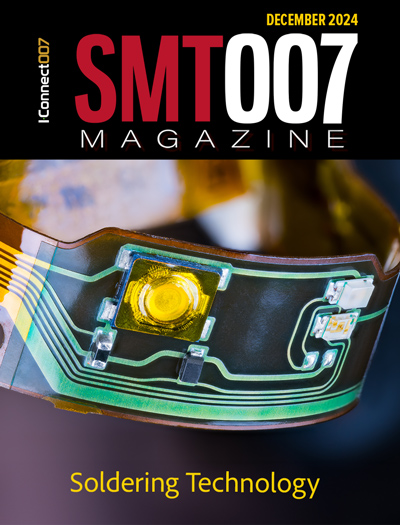-

- News
- Books
Featured Books
- smt007 Magazine
Latest Issues
Current Issue
The Path Ahead
What are you paying the most attention to as we enter 2025? Find out what we learned when we asked that question. Join us as we explore five main themes in the new year.

Soldering Technologies
Soldering is the heartbeat of assembly, and new developments are taking place to match the rest of the innovation in electronics. There are tried-and-true technologies for soldering. But new challenges in packaging, materials, and sustainability may be putting this key step in flux.

The Rise of Data
Analytics is a given in this industry, but the threshold is changing. If you think you're too small to invest in analytics, you may need to reconsider. So how do you do analytics better? What are the new tools, and how do you get started?
- Articles
- Columns
Search Console
- Links
- Media kit
||| MENU - smt007 Magazine
Close to 50% of European and North American Homes Will be Smart by 2028
October 24, 2024 | Berg InsightEstimated reading time: 2 minutes
According to a new research report from the IoT analyst firm Berg Insight, the number of smart homes in Europe and North America reached 126.2 million in 2023. North America is the leading market in terms of penetration and 41 percent of all households in the region had at least one smart home product or system at the end of the year which equals 60.8 million smart homes. Market growth is expected to continue in the next five years. By 2028, Berg Insight estimates that about 83.8 million homes in North America will be smart, equal to 55 percent of all homes in the region. The European market is still somewhat behind the North American, in terms of market penetration. There was a total of 65.5 million smart homes in Europe at the end of 2023, equaling a market penetration of 28 percent. The number of smart homes in the region is forecasted to reach about 101.2 million at the end of 2028, representing a market penetration of close to 42 percent.
The most popular smart home products include smart thermostats, smart light bulbs, smart security cameras, smart door locks, smart speakers and floor cleaning robots. These products have sold in the hundreds of millions and are marketed by incumbent OEMs such as Signify, Resideo, Danfoss, Belkin, Chamberlain, Schlage, Assa Abloy and iRobot and newer entrants such as Ecobee, Sonos, Arlo, Nuki, Mysa, IKEA, Wyze Labs and SharkNinja. The market for whole-home systems is served by traditional home automation specialists, home security providers, telecom operators and DIY solution providers. In the North American market, interactive home security systems have emerged as one of the most common types of smart home systems. The largest home security providers include ADT, Vivint, SimpliSafe, Comcast and Telus. Leading home automation companies in the region include Control4, Crestron and Savant Systems. In Europe, traditional home automation systems and DIY solutions are more common as whole-home systems, although large home security providers in the region account for an increasing share of the market. eQ-3, Shelly, Verisure, Somfy and Loxone are estimated to be the leading providers of whole-home systems in the region. The installed base of whole-home systems in Europe and North America amounted to 28.9 million systems and 40.0 million systems respectively at the end of 2023.
The smart home market growth stalled in 2023 amid higher inflation rates and increasing cost of living across Europe and North America. The market is expected to rebound in 2024 and continue its growth trajectory in the next years. “Smart and connected products and services in the home provide peace of mind and enable cost-savings and enhanced security”, says Martin Apelgren, Principal Analyst at Berg Insight. These are valuable features that consumers are willing to pay for. Much effort is now being put into developing smart home devices that work seamlessly together and facilitate the buying and setup process for consumers. The Matter standard has had a number of challenges since first being revealed and the rollout has been slow. In time, the standard is expected to have a great unifying force in the smart home market. “There is no doubt that homes will become increasingly connected and advanced in the years ahead”, concludes Mr. Apelgren.
Suggested Items
Universal Electronics Inc. Expands UEI TIDE Family Portfolio with New Features and Capabilities
01/02/2025 | BUSINESS WIREUniversal Electronics Inc. (UEI), a global leader in smart home technology, is excited to announce the expansion of its UEI TIDE family portfolio, showcasing new features and capabilities at the upcoming International Consumer Electronics Show (CES) in Las Vegas this January.
Universal Electronics Unveils Revolutionary QuickSet homeSense Technology at CES
01/01/2025 | BUSINESS WIREUniversal Electronics Inc. (UEI), a global leader in smart home technology, is thrilled to announce the launch of its groundbreaking QuickSet homeSense technology at the upcoming International Consumer Electronics Show (CES) in Las Vegas this January.
DuPont and Habitat for Humanity International Continue Global Partnership
11/18/2024 | PRNewswireHabitat for Humanity International and DuPont today announced they are renewing their annual global partnership. As part of the collaboration,
Smart Home Market on Track for Rebound Thanks to Emerging Regions
10/03/2024 | IDCGlobal shipments of smart home devices are set to stall once again in 2024 as volume remains flat with 0.6% growth to 892.3 million devices, according to the International Data Corporation (IDC) Worldwide Quarterly Smart Home Device Tracker.
Synaptics Astra AI-Native IoT Platform Launches with SL-Series Embedded Processors and Machina Foundation Series Development Kit
04/08/2024 | SynapticsSynaptics® Incorporated launched the Synaptics Astra platform with the SL-Series of embedded AI-native Internet of Things (IoT) processors and the Astra MachinaTM Foundation Series development kit.


